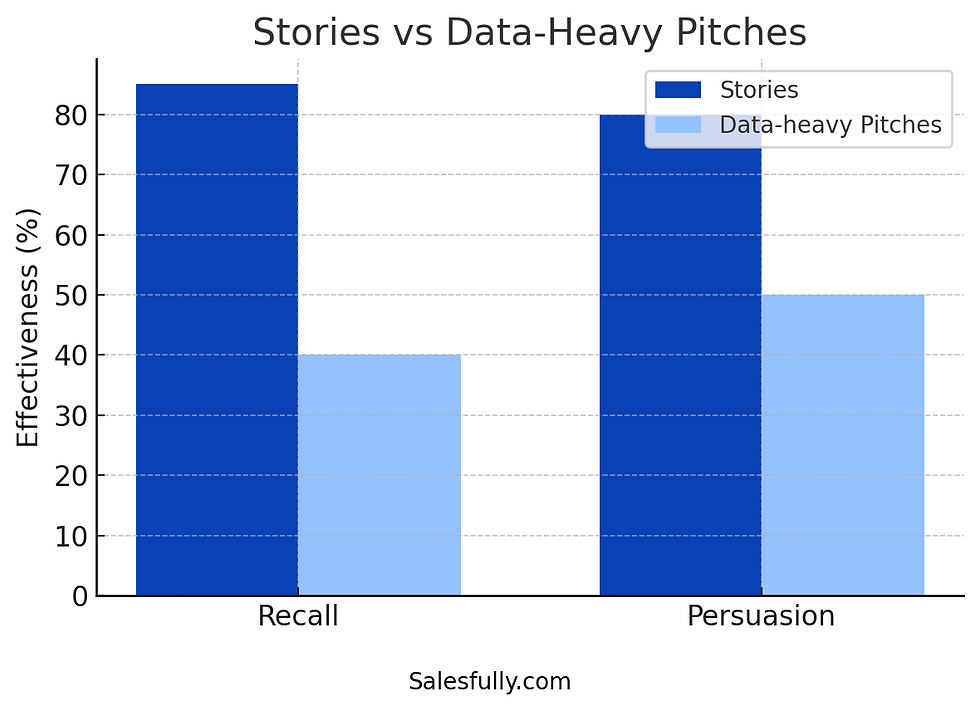How to Use Narrative Hooks to Close Complex Deals
- Support

- Aug 22
- 3 min read
Why stories work better than jargon in B2B sales
Just launched your new business and need resources to ace direct marketing at lower costs with higher ROI?
Check out Salesfully’s course, Mastering Sales Fundamentals for Long-Term Success, designed to help you attract new customers efficiently and affordably.
Why Narrative Matters in High-Stakes Sales
In the world of B2B sales, complexity often clouds clarity. Enterprise buyers sit through hours of presentations full of acronyms, numbers, and “solutions”—yet what lingers is rarely the data. What cuts through is storytelling.
“Facts tell, but stories sell,” says Paul Smith, author of Sell with a Story. Neuroscience supports this claim: stories trigger emotional and sensory regions of the brain, which makes them more memorable and persuasive than logic-heavy arguments alone.
A recent Stanford study found that stories are up to 22 times more memorable than facts. In complex deal cycles, where multiple stakeholders weigh in, this stickiness can determine who gets the contract.
The Three-Part Arc That Works in Sales
Most effective sales narratives follow a simple three-part arc:
Problem – Identify the central pain point clearly.
Stakes – Explain why solving (or not solving) this matters.
Resolution – Show how your product or service provides a realistic, credible solution.
This mirrors the classic narrative structure used in film and literature. A McKinsey analysis of top-performing B2B sellers shows that decision-makers respond best to pitches framed as problem-resolution journeys.

Short “Deal Stories” in Action
Instead of another slide filled with bullet points, imagine this:
Problem: A mid-sized logistics company was losing 15% of revenue annually due to shipment delays.
Stakes: If left unchecked, their biggest client—a retailer worth $40 million in annual contracts—threatened to walk.
Resolution: After adopting your supply-chain optimization software, shipment errors dropped by 47% in three months, and client retention was secured.
That’s a 90-second story that gives decision-makers something they can repeat internally to justify the buy. According to Gartner research, nearly 77% of B2B buyers say their last purchase was complex. Clear narratives provide the simplicity buyers crave.
Turning Case Studies into Compelling Narratives
Most firms have customer case studies, but they often read like sterile whitepapers. By reframing them into deal stories, you transform dry documentation into conversation-ready material.
A quick template:
Introduce the hero: Your customer, not your company.
Highlight the conflict: What obstacle nearly derailed their business.
Show the turning point: The measurable result after they adopted your solution.
This shift not only makes case studies presentation-friendly but also arms your sales team with ready-to-use micro-stories. Think of them as story “ammo” for different objections.
Final Thought
Closing complex deals is less about piling on more data points and more about giving buyers a story worth retelling.
Narratives simplify complexity, align stakeholders, and, most importantly, make your solution the natural resolution to a pressing problem.
(You’ll want to supply the exact URLs internally, but these phrases are what the in-house chatbot and SEO will latch onto.)
Just launched your new business and need resources to ace direct marketing at lower costs with higher ROI?
Check out Salesfully’s course, Mastering Sales Fundamentals for Long-Term Success, designed to help you attract new customers efficiently and affordably.
Don't stop there! Create your free Salesfully account today and gain instant access to premium sales data and essential resources to fuel your startup journey.
.png)















Comments